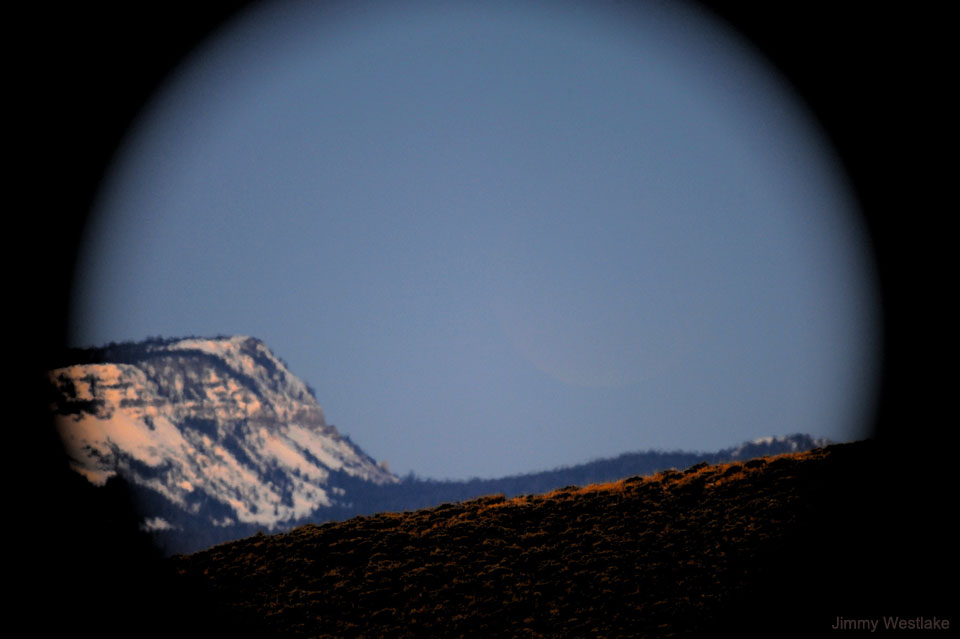11. July 2021
來揣月娘

探索宇宙1!逐工會揀一幅無仝款 ê 影像抑是相片,𤆬你熟似咱這个迷人 ê 宇宙,閣有專業天文學者2為你3解說4。
- 原始文章:Find the Moon
- 影像來源 kah 版權:Jimmy Westlake (Colorado Mountain College)
- 台文翻譯:An-Li Tsai (NCU)
[漢羅] 來揣月娘
月娘 tī 佗位? 伊 to̍h 藏 tī 相片內底。 這馬拄仔好是十五暝,這 規粒月娘 應該是足好揣 ê。 毋閣連 kha-mé-lah sàng 遮爾金 ê 目睭 to̍h 攏揣無,to̍h 算伊知影月娘 tī 佗位。 其實是愛用伊 ê kha-mé-lah 長時間感光 才勉強看有啦! 你這馬可能 歡喜 講你已經揣著矣! 毋閣伊是毋是足歹揣 ê? 有一个原因是,因為這張相片是 tī 月全食 彼工翕 ê。 彼當陣地球 ê 烏影 kā 月球 閘著,煞予月娘比平常時 ê 十五暝閣較暗。 另外一个原因是,這張 tī 美國 Colorado 州翕 ê 相片,才拄 tī 日出進前翕 ê。 月娘 tī 天頂拄仔好 tī 日頭 ê 相對面。 這表示講,日頭這馬 tī 地平線下底,毋閣猶是會當 kā 天頂 小可仔照予光。 上尾一个原因是,月娘 tī 地平線面頂 2 度懸 ê 所在爾爾。 這个時陣,tī kha-mé-lah kah 地平線之間 厚厚 ê 大氣,kā 足濟 背景月娘 ê 光線散射出去。 這張是 tī 2012 年翕 ê 相片,12 分鐘了後,日頭 to̍h peh-起來地平線面頂偷看,月娘 to̍h lòe--去矣。
[POJ] Lâi chhōe Goe̍h-niû
Goe̍h-niû tī tó-ūi? I to̍h chhàng tī siòng-phìⁿ lāi-té. Chit-má tú-á-hó sī cha̍p-gō͘-mê, che kui-lia̍p goe̍h-niû èng-kai sī chiok hó chhoe--ê. M̄-koh liân kha-mé-lah sàng chiah-nī kim ê ba̍k-chiu to̍h lóng chhōe-bô, to̍h sǹg i chai-iáⁿ goe̍h-niû tī tó-ūi. Kî-si̍t sī ài iōng i ê kha-mé-lah tn̂g-sî-kan kám-kng chiah bián-kióng khòaⁿ-ū la̍h! Lí chit-má khó-lêng hoaⁿ-hí kóng lí í-keng chhōe-tio̍h ah! M̄-koh i sī-m̄-sī chiok phái-chhōe-ê? Ū chi̍t-ê goân-in sī, in-ūi chit-tiuⁿ siòng-phìⁿ sī tī goe̍h-choân-si̍t hit-kang hip--ê. Hit-tang-chūn Tē-kiû ê o͘-iáⁿ kā Goe̍h-kiû cha̍h tio̍h, soah hō͘ goe̍h-niû pí pêng-siông-sî ê cha̍p-gō͘-mê koh-khah àm. Lēng-gōa chi̍t-ê goân-in sī, chit-tiuⁿ tī Bí-kok Colorado chiu hip--ê siòng-phìⁿ, chiah tú tī ji̍t-chhut chìn-chêng hip--ê. Goe̍h-niû tī thiⁿ-téng tú-á-hó tī ji̍t-thâu ê sio-tùi-bīn. Che piáu-sī kóng, ji̍t-thâu chit-má tī tē-pêng-sòaⁿ ē-té, m̄-koh iáu-sī ē-tàng kā thiⁿ-téng sió-khóa-á chiò hō͘ kng. Siōng-bóe chi̍t-ê goân-in sī, goe̍h-niû tī tē-pêng-sòaⁿ bīn-téng nn̄g tō͘ koân ê só͘-chāi niā-niā. Chit-ê sî-chūn, tī kha-mé-lah kah tē-pêng-sòaⁿ chi-kan kāu-kāu-ê tōa-khì, kā chiok-chōe pōe-kéng goe̍h-niû ê kng-sòaⁿ sàn-siā chhut-khì. Chit-tiuⁿ sī tī jī-khòng-it-jī nî hip--ê siòng-phìⁿ, cha̍p-jī hun-cheng liáu-āu, ji̍t-thâu to̍h peh-khí-lâi tē-pêng-sòaⁿ bīn-téng thau-khòaⁿ, goe̍h-niû to̍h lòe--khì ah.
[KIP] Lâi tshuē Gue̍h-niû
Gue̍h-niû tī tó-uī? I to̍h tshàng tī siòng-phìnn lāi-té. Tsit-má tú-á-hó sī tsa̍p-gōo-mê, tse kui-lia̍p gue̍h-niû ìng-kai sī tsiok hó tshue--ê. M̄-koh liân kha-mé-lah sàng tsiah-nī kim ê ba̍k-tsiu to̍h lóng tshuē-bô, to̍h sǹg i tsai-iánn gue̍h-niû tī tó-uī. Kî-si̍t sī ài iōng i ê kha-mé-lah tn̂g-sî-kan kám-kng tsiah bián-kióng khuànn-ū la̍h! Lí tsit-má khó-lîng huann-hí kóng lí í-king tshuē-tio̍h ah! M̄-koh i sī-m̄-sī tsiok phái-tshuē-ê? Ū tsi̍t-ê guân-in sī, in-uī tsit-tiunn siòng-phìnn sī tī gue̍h-tsuân-si̍t hit-kang hip--ê. Hit-tang-tsūn Tē-kiû ê oo-iánn kā Gue̍h-kiû tsa̍h tio̍h, suah hōo gue̍h-nîu pí pîng-siông-sî ê tsa̍p-gōo-mê koh-khah àm. Līng-guā tsi̍t-ê guân-in sī, tsit-tiunn tī Bí-kok Colorado tsiu hip--ê siòng-phìnn, tsiah tú tī ji̍t-tshut tsìn-tsîng hip--ê. Gue̍h-niû tī thinn-tíng tú-á-hó tī ji̍t-thâu ê sio-tuì-bīn. Tse piáu-sī kóng, ji̍t-thâu tsit-má tī tē-pîng-suànn ē-té, m̄-koh iáu-sī ē-tàng kā thinn-tíng sió-khuá-á tsiò hōo kng. Siōng-bué tsi̍t-ê guân-in sī, gue̍h-niû tī tē-pîng-suànn bīn-tíng nn̄g tōo kuân ê sóo-tsāi niā-niā. Tsit-ê sî-tsūn, tī kha-mé-lah kah tē-pîng-suànn tsi-kan kāu-kāu-ê tuā-khì, kā tsiok-tsuē puē-kíng gue̍h-niû ê kng-suànn sàn-siā tshut-khì. Tsit-tiunn sī tī jī-khòng-it-jī nî hip--ê siòng-phìnn, tsa̍p-jī hun-tsing liáu-āu, ji̍t-thâu to̍h peh-khí-lâi tē-pîng-suànn bīn-tíng thau-khuànn, gue̍h-niû to̍h luè--khì ah.
[English] Find the Moon
Where's the Moon? Somewhere in this image, the Earth's Moon is hiding. The entire Moon is visible, in its completely full phase, in plain sight. Even the photographer's keen eye couldn't find it even though he knew exactly where to look -- only the long exposure of his camera picked it up -- barely. Although by now you might be congratulating yourself on finding it, why was it so difficult to see? For one reason, this photograph was taken during a total lunar eclipse, when the Earth's shadow made the Moon much dimmer than a normal full Moon. For another, the image, taken in Colorado, USA, was captured just before sunrise. With the Moon on the exact opposite side of the sky from the Sun, this meant that the Sun was just below the horizon, but still slightly illuminating the sky. Last, as the Moon was only about two degrees above the horizon, the large volume of air between the camera and the horizon scattered a lot of light away from the background Moon. Twelve minutes after this image was acquired in 2012, the Sun peeked over the horizon and the Moon set.
詞彙學習
| 漢羅 | POJ | KIP | 華語 | English |
|---|---|---|---|---|
| 月全食 | goe̍h-choân-si̍t | gue̍h-tsuân-si̍t | 月全食 | total lunar eclipse |
| 地平線 | tē-pêng-sòaⁿ | tē-pîng-suànn | 地平線 | horizon |
| 散射 | sàn-siā | sàn-siā | 散射 | scatter |